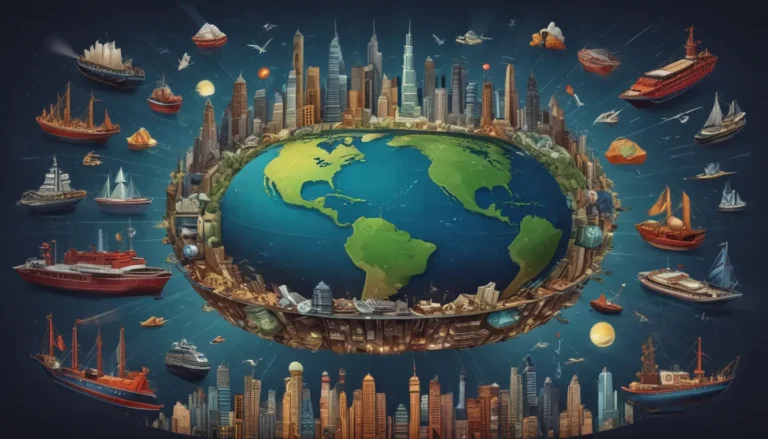A Note About Images: The images used in our articles are for illustration purposes only and may not exactly match the content. They are meant to engage readers, but the text should be relied upon for accurate information.
The global population is a complex and ever-evolving topic that encompasses various facets, from demographics to cultural dynamics, economics to migration patterns. Understanding the intricacies of global population is essential in addressing societal challenges and shaping policies for a sustainable future. In this article, we will delve into 17 enigmatic facts about global population that shed light on its diversity, patterns, and trends. These facts will provide valuable insights into the complex dynamics shaping our world today and in the years to come. So, fasten your seatbelts and embark on an eye-opening journey into the fascinating realm of global population!
Unveiling Key Insights:
- The global population is on a rapid growth trajectory, with Africa leading the way.
- Urbanization, aging, and migration are pivotal factors shaping our future.
- By 2050, the world’s population is projected to reach 9.7 billion, presenting unique challenges for countries worldwide.
Unveiling the Facts:
The Growing Global Population:
The global population is expanding at an unprecedented rate, with estimates projecting a staggering 9.7 billion by the year 2050. This rapid growth poses challenges for governments, economies, and the environment, necessitating strategic planning for sustainable development.
China Takes the Lead:
With over 1.4 billion people, China holds the title of the most populous country on Earth. Following closely behind is India, with approximately 1.3 billion inhabitants, showcasing the density and diversity of global population distribution.
Africa’s Exponential Growth:
Africa is the fastest-growing region globally, with its population experiencing exponential growth. By 2050, Africa is expected to surpass 2.5 billion people, accounting for a significant portion of the world’s total population and highlighting the region’s dynamic demographic landscape.
Japan’s Demographic Challenge:
Japan is grappling with a significant demographic issue as its birth rates decline, leading to one of the lowest fertility rates globally. This trend has implications for an aging population and potential labor shortages, underscoring the importance of addressing demographic challenges proactively.
The Urbanization Trend:
More than half of the global population now resides in urban areas, marking a shift towards urbanization. With over 55% of the population living in cities, this trend is expected to continue, posing both opportunities and challenges in terms of social, economic, and environmental implications.
India’s Ascent to the Top:
Demographic projections indicate that India is poised to surpass China as the world’s most populous country by 2027. This demographic shift carries significant implications for both countries and the global community, highlighting the evolving dynamics of global population distribution.
Embracing the Aging Population:
As healthcare advances and life expectancies increase, the global median age is on the rise. This demographic shift poses challenges in healthcare, retirement systems, and workforce dynamics, emphasizing the need for proactive planning to address the implications of an aging population effectively.
Navigating Urbanization Dynamics:
Rapid urbanization is reshaping the global population landscape, with more individuals migrating to cities in search of opportunities. This trend has profound social, economic, and environmental implications, underscoring the need for sustainable urban development strategies.
Gender Dynamics in Population:
While the ratio varies across regions, women generally outnumber men in the global population. This gender imbalance carries significant implications for societal structures, gender dynamics, and policy considerations, highlighting the importance of promoting gender equality and empowerment.
Unveiling Population Disparities:
Population growth is unevenly distributed across the globe, with some regions experiencing rapid growth while others face declining populations. These disparities underscore the need for tailored approaches to address unique demographic challenges and foster inclusive and sustainable development.
Tackling Aging Population Challenges:
Due to declining birth rates and increased life expectancy, the global population is rapidly aging. This demographic shift presents challenges in healthcare, retirement planning, and support systems for the elderly, necessitating innovative solutions to meet the evolving needs of aging populations.
Diverse Urban Population Densities:
While urban areas are growing, population densities vary widely among cities. Some cities are densely populated, while others have more spacious urban landscapes, influencing infrastructure, resource allocation, and quality of life considerations in urban settings.
The Role of Migration:
Migration plays a pivotal role in shaping population dynamics, influencing growth patterns, cultural diversity, and economic dynamics. People migrate for various reasons, including economic opportunities, political factors, and social considerations, underscoring the interconnected nature of global population trends.
Addressing Climate Change Impacts:
As climate change accelerates, it will have profound effects on population patterns, leading to forced migration and displacement due to rising sea levels, extreme weather events, and environmental degradation. Sustainable planning and adaptation strategies are essential to mitigate the impacts of climate change on global populations.
Balancing Resource Availability:
The growing global population exerts pressure on essential resources such as food, water, and energy, highlighting the importance of sustainable resource management. Ensuring equitable access to resources is crucial for maintaining the well-being of current and future generations and fostering sustainable development.
Empowering Through Education and Healthcare:
Access to quality education and healthcare services plays a vital role in managing population growth and promoting overall well-being. By empowering individuals with knowledge and healthcare resources, informed choices can be made, contributing to sustainable development and improved quality of life.
Diverse Population Policies:
Countries implement a range of population policies to address their unique demographic challenges, including incentives for family planning, immigration regulations, and strategies for aging populations. Tailored approaches are essential to navigate the diverse demographic landscapes and promote inclusive and sustainable development.
A Brighter Future Awaits:
In conclusion, the enigmatic world of global population presents a myriad of challenges and opportunities that shape our collective future. By exploring the intricate trends, demographics, and migration patterns of world population, we can gain valuable insights into the complexities at play and devise sustainable solutions for a brighter and more equitable future for all. Let us harness these insights to navigate the dynamic landscape of global population and pave the way for a prosperous tomorrow.
Frequently Asked Questions:
Q: What is the current global population?
A: As of the latest estimates, the global population stands at approximately 7.9 billion people.
Q: Is the global population evenly distributed around the world?
A: No, the global population is not evenly distributed, with regions varying in population density.
Q: What factors contribute to population growth?
A: Population growth is influenced by birth rates, death rates, migration patterns, and socio-economic development.
Q: How has the global population changed over time?
A: The global population has more than tripled since 1950, experiencing significant growth over the past century.
Q: Is the world population expected to continue growing?
A: While growth rates are slowing, the global population is projected to increase, albeit at a decreasing rate over time.
Q: What is the impact of population growth on the environment?
A: Population growth can strain natural resources, contribute to environmental degradation, and impact biodiversity, highlighting the importance of sustainable population management.
Q: How does population density influence society?
A: Population density impacts infrastructure, healthcare systems, education, and resource access, shaping societal dynamics and opportunities for innovation and growth.
Q: What challenges are associated with an aging population?
A: Aging populations pose challenges such as increased healthcare costs, workforce shortages, and retirement planning concerns, requiring strategies to support the needs of aging individuals effectively.
Q: How does migration impact global population dynamics?
A: Migration influences population growth, cultural diversity, and economic dynamics, shaping demographic trends in both origin and destination regions.
Q: How can sustainable population growth be ensured?
A: Sustainable population growth requires access to education, healthcare, family planning services, gender equality promotion, addressing socio-economic disparities, and fostering inclusive development approaches.
Join Us in Exploring the Enigmatic World of Global Population:
Our commitment to delivering trustworthy and engaging content fuels our exploration of the ever-evolving realm of global population. Each fact shared is contributed by individuals like you, offering diverse insights that enrich our understanding of the intricacies shaping our world. Trust in our dedication to quality and authenticity as we navigate the complexities of global population trends together, striving towards a sustainable and prosperous future for all.






